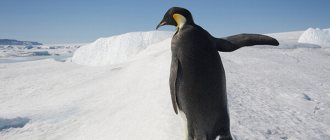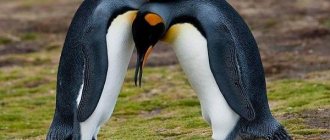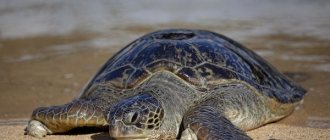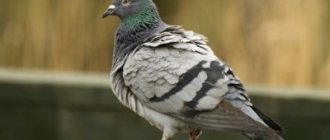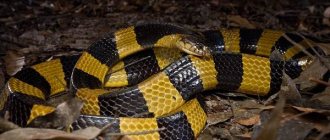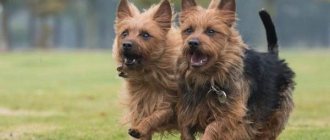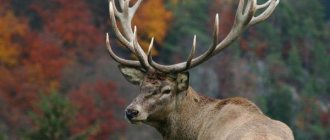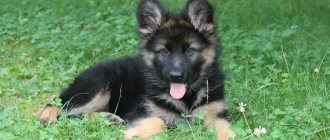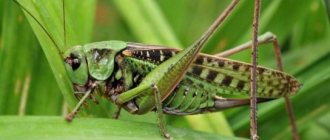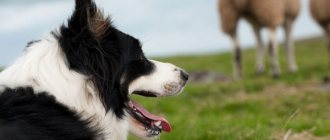Genus emperor penguins
This genus was the first to separate from the family root, and is therefore called basal. There are only 2 types. One is nominative - imperial, the other, also with a monarchical name - king penguins. These types of penguins in the photo are proud and majestic.
In birds belonging to this genus, the paws play a special role. They serve not only as supports for holding the body in an upright position. At the crucial moment of incubating the egg and protecting the fledgling baby from the cold, they act as a kind of nest.
Penguin feet are not protected from the cold by feathers. The closely intertwined venous and arterial vessels help them avoid freezing. Warmer venous blood gives its temperature to arterial blood. There is a constant process of self-heating. Not only are the paws preserved, the makeshift nest is warmed.
View of emperor penguins
Discovered in 1820, during the voyage of Russian ships under the command of Bellingshausen and Lazarev to the shores of Antarctica. These birds made a great impression on the discoverers. Therefore, they received the highest title that existed at that time.
The birds are impressive in size. Their height is close to 130 cm. And their weight, with enough food, can reach up to 50 kg. The color is strict and solemn. The white belly merges into a pale yellow chest. The jet-black back and wings create the feeling of a tails dress. The beak is slightly hooked. There are yellow spots on the black head, closer to the neck.
The feathers are laid like three-layer fur, providing warmth and moisture insulation. Molting deprives birds of their protective covering. Until it ends, the birds remain on land, that is, they starve. Feather renewal takes place actively and almost simultaneously throughout the body. Therefore, the bird only has to starve for one to two weeks due to molting.
Colonies are created far from the coastline. Penguins make long journeys (up to 50-100 km) in order to be in the company of adult males and females and deal with the issue of reproduction. The approach of the Antarctic winter and the associated reduction in daylight hours are pushing them to begin the path to reproduction.
Once in the colony, the birds begin to look for a mate. Males wander through the bird congregation lowering and raising their heads. The free female reacts to these bows. Standing opposite each other, the birds bow. Having made sure that the desires are reciprocal, the penguins begin to walk as a couple. It should be noted that leisurely courtship and further actions take place at a temperature of -40 °C.
Monogamy among emperor penguins lasts only one season. In the harsh world of Antarctica, you need to take advantage of the first favorable opportunity for reproduction. There is no reason to wait for last year's partner to come to the colony. The window of opportunity is too short.
In May-June, the female produces one 470-gram egg. By weight, the egg seems large, but relative to the weight of the female, it is one of the smallest bird eggs. Only 2.3% of the mass of the parent is the penguin embryo enclosed in a shell.
Once laid, the egg is passed to the male. He alone preserves and warms the future penguin for about 70 days. The female goes to the ocean to feed. She is exhausted, her body requires food. Males also have a hard time. The colony, organizing a dense group, escapes from the cold and wind by clinging to each other, turning their backs to the wind.
During the mating season, including incubation, males lose 40% of their weight. The chicks incubate for 2-3 months. By the time they emerge, the females return with fish in their esophagus, which they feed the chicks. Adult birds go to the ocean for food until January. After which the colony disintegrates. All the birds go for fish.
Body structure
Nature made sure that penguins skillfully move through the water, so their body shape is streamlined. Birds have strong muscles. The structure of bone tissue helps the wings work like screws. Innate adaptation; helps to hunt in water.
The chest of penguins has a pronounced keel. Muscles are attached to the keel and shoulder blades. She is responsible for lifting the wing.
Penguins have a very short tail, which tends to act as a rudder.
Penguin bones are not tubular, like those of other birds, but with internal cavities. They are similar to the bones of seals and dolphins.
Thermoregulation and plumage
The birds of the north do not freeze. Why? Birds have special plumage: thick, short feathers tightly cover the body and fit together. This structure prevents heat from leaving the bird’s body and the wind from blowing it through.
The second protective factor is a layer of fat up to 1 cm. Thanks to it, penguins swim in icy water. However, the wings and paws are devoid of feathers - these are the weakest points. In order not to freeze, birds have established thermoregulation: when the limbs become very cold, warm arterial blood is supplied to them. Having reached problem areas, it transfers its heat to venous blood, which flows in reverse; into the body.
Vision and hearing
The eyes are adapted to the fact that birds spend most of their time under water. The cornea is flat, so mild myopia is observed. Contraction of the pupils allows the eye to become accustomed to illumination at different depths.
The structure of the ears is not clearly defined. When immersed, they adhere to the body and are tightly covered with feathers, which does not allow water to penetrate the ears.
King penguins
These birds have more modest parameters. They reach a height of 1 meter. Weight, at best, reaches 20 kg. The color of both species is similar. But king penguins are decorated with brighter, orange spots in the ear area and on the chest.
The habitat of penguins with the monarchical name is the subantarctic islands located from 44° south latitude. to 56° S In the last century, penguin nesting sites on many islands have almost disappeared, due to bird fat.
This material nearly wiped out the island's king penguin populations. Sailors killed birds only for fat. Today, mindless killings have stopped. The total number of birds exceeds 2 million individuals. That is, they are not in danger of extinction.
King penguins become adults at 3 years of age. The process of procreation usually begins at 5 years of age. In October, mature penguins gather in colonies. Males begin to walk around the cluster of birds, demonstrating their readiness. Their mating dance is head tilting. Pairs form quite quickly.
The female brings one 300-gram egg. Unlike the imperial relatives, it is hatched by not only the male, but also the female. After about 50 days, almost naked chicks appear. Parents have to protect them no less diligently than an egg. After 30-40 days, the chick begins to develop elements of independence.
Reproduction and lifespan
These birds seriously devote a significant part of their lives to reproduction. In spring or early summer they return to their old nesting sites, and from this moment vigorous mating activity develops. King penguins live in large groups during the breeding season.
They are all crowded together on one piece of land, and those that do not fit go into the water. The birds on the ground line up like a regiment of soldiers, not only in rows, but also in height. Young individuals are in one place, molting ones are in another, brooding females are in a third, and males are in a fourth.
They have the longest breeding season of any bird. From marriage and egg laying to the appearance of offspring, 14-16 months pass. A pair of penguins would happily breed every year, they do everything possible to do this, but it usually happens once every 2 years. Sometimes males cannot divide the female.
Then you can watch the fight between the contenders. But the choice remains with the female. Having decided on a couple, they perform a beautiful mating dance. They do not make nests, but choose areas of land that have thawed from the ice for laying. There they dig deep holes in the frozen ground.
The nest consists of a hole and is very deep. Sometimes such burrows communicate with each other through underground passages. Smooth paths, like sidewalks, lead to the nesting site. The female lays one egg on her paws, hiding it under the folds of her abdomen.
And for 55 days he and his father alternately kept him in this position. Moreover, these birds can steal each other’s eggs if their own cub dies. Their parental instinct is very great. Therefore, the couple vigilantly monitors their egg both day and night.
When a king penguin chick is born, one of the parents goes to sea to look for food. The second one stays and warms him with its warmth. And this lasts until the baby learns to warm himself by regulating his body temperature. The baby grows up under the caring care of his mother. The lifespan of birds in the wild is approximately 20-25 years. With good care, the zoo had long-livers up to 35 years old.
Magnificent penguins
From this genus, one species has survived to this day - this is a penguin with a yellow stripe from the eyes, along the back of the head, around the head. The common name is the yellow-eyed penguin. The Maori, New Zealand's aboriginal population, gave it the name "huaho". It is read that this is a very rare species of penguin . It grows up to 60-80 cm. In the full season it weighs about 8 kg. The yellow-eyed is the fourth largest penguin in terms of mass and size.
Huaho breed along the east coast of New Zealand, Steward Island, Auckland Island and others. The number and growth rate of juveniles indicate the possibility of extinction of these birds in the next 2-3 decades. The reason, according to scientists, lies in warming, pollution, and fishing.
New Zealand entrepreneurs have begun to use penguin colonies to attract tourists. Exotic lovers are taken to the beaches of Oamaru, Otago Peninsula, where they can observe unusual seabirds, especially since yellow-eyes are rare in captivity. They are categorically not satisfied with artificial conditions for reproduction.
Plump "men" are always held in high esteem
In some species, the male penguin incubates the eggs, and the females go on a hunt, which can last up to several weeks. Therefore, the females of these birds, as a rule, do not look at fighting skills or a loud voice, but at the fatness of their future partner. And they choose males with a sufficient supply of fat who can live all this time without food.
The doctor explained why it is important to monitor your pace when jogging
Bobo, ruffles, patchwork: trendy denim items this spring that suit everyone
The age difference does not bother them: the young wife of Vladimir Gostyukhin
Little penguins
This genus includes one nominative species, the little or blue New Zealand penguin. The main difference from other members of the family is their nocturnal lifestyle. Birds, to some extent, can be considered burrowing animals. They spend the whole day in recesses and natural burrows, and at night they go fishing.
Timidity is the main quality of these small birds. Their weight rarely exceeds 1.5 kg. To gain such mass, small penguins have to swim 25 km from the coast and hunt small fish and cephalopods there. In the coastal strip they catch crustaceans.
This bird was first recorded and described in 1871 by the German researcher Reinhold Forester. But there is still debate among biologists. For example. There is a species of white-winged penguin. It is considered a subspecies of the small one, but some authors classify it as an independent species. DNA studies of birds are being carried out, but the issue has not been finally resolved.
The white-winged penguin inhabits the New Zealand province of Canterbury. On coastal slopes, white-winged birds construct simple burrows in which they perch during the day. In the evening, in the dark, they go to the ocean. This habit saves from sea birds of prey, but protects from small predators brought to these lands by Europeans.
The governments of the Commonwealth of Australia and neighboring New Zealand have introduced bans on the destruction of penguins. Made protected areas where birds gather in colonies. But fishing, particularly nets, oil spills, ocean debris, climate change and a weakening food supply are leading to declines in penguin numbers.
Population and species status
Climate change, which leads to warming processes, plays a huge role in preserving the species. Warming is insidious in that rising temperatures lead to the melting of glaciers, which serve as a natural home for penguins. The loss of natural habitat is leading to a decline in the birth rate of emperor penguins. In addition, rising environmental temperatures lead to the extinction of various species of fish, mollusks and crustaceans, which form the basis of the penguins’ diet.
Humans also contribute to the reduction in the number of these unique birds by introducing themselves into their living space. Humans catch large quantities of fish and other inhabitants of the seas and oceans that constitute the diet of penguins, significantly reducing the food supply. After some time, the species diversity of the deep sea began to decline significantly.
Recently, people have begun to give preference to extreme tourism, which involves introducing thrill-seekers to the most inaccessible places on our Planet. Antarctica especially attracts such hobbyists, which leads to the clogging of emperor penguin habitats.
Contact with the local population. Emperor penguins
Crested penguins
This genus includes 7 existing species. Some of them are quite numerous. But one - species 8 - became extinct in the 19th century. The full height of the birds reaches 50-70 cm. The overall appearance is that of a penguin, but there is a multi-colored feather decoration on the head, which gives their image individuality. The names of penguin species reflect their external features or nesting sites.
- Crested penguin. Nominative species. As befits a crested penguin, the black and white outfit is decorated with yellow feather caps and crests.
- Golden-haired penguin. It is known how many species of penguins are included in the family. There are 40 million of them. Half of the penguin population are golden-haired birds.
- Northern crested penguin. These birds were recently identified as a separate taxon. For their forced ability to climb rocks, they are called rock climbers. Or rocky golden-haired penguins. These flightless birds create primitive nests on steep slopes. Where a land predator cannot reach. Unfortunately, this does not save you from air pirates.
- Thick-billed penguin. Despite their small numbers, thick-billed penguins cannot be classified as an endangered species of penguin . Hope for the conservation of the species is associated with the remoteness of habitats and the practical absence of terrestrial enemies.
- Snare crested penguin. Birds nest on the tiny Snares Archipelago. Its area is just over 3 square meters. km. Externally, this bird differs little from its relatives. A light spot at the base of the thick brown beak can serve as an identifying mark.
The home island is not a pile of stones. It has bushes and trees, and what we used to call a forest. The island is especially good because there are no predators on it. Therefore, Snar crested penguins create nests on coastal slopes and in the distance, in the Snar forest.
- Schlegel's Penguin. Resident of Macquarie Island. A remote island in the South Pacific is the only place where this bird produces offspring. Neighboring with other sea birds, these beauties have multiplied to 2-2.4 million individuals.
- Great crested penguin. It is sometimes called Sclater's penguin. Resident of the Antipodes and Bounty Islands. The species is poorly studied. Its numbers are decreasing. It is considered a critically endangered bird.
It should be mentioned that not all biologists agree with this species classification of crested birds. Some believe that there are only 4 species. And the first three from the list are subspecies of the same species.
Chinstrap penguins
They occupy, together with the imperial ones, the southernmost positions when creating colonies. Being on rocky shores, they create simple nests from pebbles. When hatching chicks on continental glaciers, this is not possible. Birds' feet serve as nests.
They go to the open ocean to find food. The place of attack on schools of small fish is sometimes located 80 km or more from the coast. Here they not only fill their stomachs, but also become targets for predators. About 10% of the total number of chinstrap penguins are preyed upon by sea lions.
- Adelie Penguin. The penguin was discovered and described by the French scientist Dumont-D'Urville. Associated with the name of the scientist’s wife. The appearance of the birds is a classic penguin style. No frills. White belly and chest, black tailcoat. About 2 million couples care for their offspring on the Antarctic islands and mainland coasts.
- Gentoo penguin. The somewhat strange common name comes from the Latin Pygoscelis papua. It was first seen and described in the Falkland Islands. This bird never really hides.
Gives itself away with a shrill and not very pleasant cry. The habitat and lifestyle replicate the area of habitat and habits exhibited by other penguin species in Antarctica . The fastest flightless seabird. In water it develops a record 36.5 km per hour. It is also the third largest member of the penguin family. Grows up to 71 cm.
- Antarctic penguin. A contrasting black stripe runs along the lower part of the face, which makes the appearance of penguins . Because of their stripes, the birds are sometimes called chinstrap penguin or bearded vultures. Their height exceeds 75 cm and weight 5 kg.
Natural enemies
Penguins are animals that nest primarily in isolated areas, so adult individuals located on land, as a rule, do not have natural enemies. However, carnivorous mammals, including dogs and cats, often imported by people, can pose quite a serious danger even to adult seabirds.
For the purpose of self-defense, penguins use elastic fins and a sharp beak, which are quite effective weapons . Chicks left unattended by their parents often become available prey for petrels (Procellariidae). Some species of seagulls also take advantage of any opportunity to feast on penguin eggs.
Penguins are often predated by leopard seals (Hydrurga lertonyx), southern fur seals (Arctocerhalus), Australian sea lions (Neorhosa cinerea) and New Zealand sea lions (Phocarctos hookeri), as well as killer whales (Orcinus oca) and sharks (Selashii). in sea waters. All of the above species of seals prefer to patrol shallow waters near numerous colonies, where penguins cannot use such a natural advantage as high maneuverability. According to many scientists, about five percent of the total number of Adélie penguins die in such places every year.
This is interesting! Most likely, it is the presence of aquatic predators that lies the main reason for the seemingly inexplicable natural fears of seabirds in front of the aquatic environment, to which absolutely all penguins are simply perfectly adapted.
Before entering or diving into the water, penguins prefer to approach the shoreline in small groups. During this movement, the animals hesitate and express indecisiveness, so quite often this simple procedure lasts half an hour. Only after one of these seabirds dares to jump into the water does all the other representatives of the colony dive.
Return to content
Spectacled or donkey penguins
Spectacleds are a species of penguin that nest far from Antarctica. For their piercing cry, similar to the roar of a four-legged domestic animal, they are often called donkeys. A contrasting stripe with uneven edges, similar to a large arch, runs along the ventral part of the body.
- Spectacled penguin. The population size is estimated at approximately 200 thousand individuals. Although a century earlier there were about a million birds of this species.
- Humboldt penguin. In Chile and Peru, where cold currents touch rocky shores, Humboldt penguins hatch their chicks. There are not many birds left - about 12,000 pairs. Scientists attribute the decrease in the number of penguins to changes in the paths of sea currents.
- Magellanic penguin. Its name immortalizes the memory of the traveler Fernand Magellan. Birds inhabit the very south of South America, the shores of Patagonia. There, 2 million loud couples have offspring.
- Galapagos penguin. A species that nests in the Galapagos, that is, on the islands near the equator. Despite the striking difference in living conditions, Galapagos penguins have not undergone changes in appearance and habits compared to other spectacled birds.
Range, habitats
The ancestors of penguins inhabited areas with temperate climatic conditions, but at that time Antarctica was not a continuous piece of ice. With climate change on our planet, the habitats of many animals have changed. Continental drift and the shift of Antarctica to the South Pole caused the migration of some representatives of the fauna, but it was the penguins that were able to adapt quite well to the cold.
The habitat of penguins is the open sea in the Southern Hemisphere, the coastal waters of Antarctica and New Zealand, the southern part of Australia and South Africa, the entire coast of South America, as well as the Galapagos Islands near the equator.
This is interesting! Today, the warmest habitat for modern penguins is the Galapagos Islands, located near the equatorial line.
Seabirds prefer cool conditions, so in tropical latitudes such animals appear exclusively with cold currents. A significant part of all modern species live between 45° and 60° south latitude, and Antarctica and its adjacent islands have the largest concentration of individuals.
Return to content
Interesting Facts
By observing Magellanic penguins, zoologists have determined that among them there are right-handers and left-handers. That is, animals are more active with one or another paw. There is not a single ambidexter (an animal with both legs equally developed). Notable is the fact that “left-footed” penguins are more aggressive. In humans, such dependence is not observed.
While foraging for food, king penguins show masterful swimming and diving skills. Hunting for fish, birds dive to a depth of 300 meters. Stay under water for more than 5 minutes. The record dive was recorded in 1983. Its depth was 345 m.
Penguins quench their thirst with salt water. Most of the time, birds simply have nowhere to get fresh food. The penguin's body has a special supraorbital gland that monitors the balance of salt and removes excess salt through the nostrils. While some animals search for sources of salt, others (penguins) have it dripping from the tip of their nose.
Out of many millions, only one penguin is called up for military service. His name is Nils Olav. Residence Edinburgh Zoo. Now the title “sir” must be added to his name. Penguin has served in the Norwegian army for many years. His career is a path from corporal to honorary commander.
True, the first half of the journey was covered by his predecessor, who died in 1988 with the rank of sergeant. The current Olaf was knighted in 2008. He is the only penguin to achieve high officer rank in the Norwegian Armed Forces.
